 |
||
|
||
| ||
Part I: Hard discs and controllersWell, Quantum hard discs are disappearing. Fireballs, so much valued by users, will no more be seen on the shelves. But on the other side, Maxtor discs may be now easier to buy :) I should note that hard discs with IDE interface have reached some kind of a deadlock, in spite of the fact that record density and capacity are slowly growing. One can produce already today IDE disc with a speed of 10,000 rpm and increased disc capacity, but the market doesn't need it. Serial ATA can become a break-through, but it will appear not earlier the next year. Another direction of disc development is improvement of acoustic characteristics. First it may seem useless to use liquid bearings when noise coming from a fan is greater than the sound of a disc motor. But the fact is that all leading manufacturers are developing a new market - a market of home equipment devices where, for example in a VCR, noise must be prevented. Sometimes, there are incidents. In many modern discs the most noise is made not by spindle rotation but by positioning of heads. The slower the heads move, the less the noise. But on the other hand, an access time will be more. Some companies (for example, IBM and Maxtor) have developed special utilities to reduce noise in such a way. It seems that everything is good: you may reduce it if you want. However, one of the Matrox discs we had managed to fetch had "quiet" mode enabled, the other had it off. Besides, there is also a "fast" variant. And not every seller might know about such utilities. That is why I recommend you to go to the manufacturer's site to check what utilities are offered for your model before you buy it. Sometimes it helps :) In a rating of hard discs there are no changes occurred. Leaders are the same. Discs from 10 to 20 GBytes 5400 rpmHere we have entry-level discs. Although performance is very high, you save a lot of money. The prices within this class differ slightly. The Seagate U5 is a leader. The Fujitsu MPF 3xxxAT is a leader of an economic class. I would recommend you to go with the Fujitsu. Discs from 10 to 20 GBytes 7200 rpmThese discs are for those who don't need to store huge volumes of data. In my opinion, a price-to-performance ratio (effectivness) is a deterrent. It is difficult to mark out a leader, that is why I give you only my humble opinion. The leader is Quantum Fireball Plus AS. In an economic class the leader is Seagate Barracuda ATA II. Discs from 20 GBytes 5400 rpmThese discs are designed only to store data. No sense to talk about high efficiency. Seagate U5 is a leader. In an economic class the leader is Western Digital WD450AA. Discs from 20 GBytes 7200 rpmA high linear read speed (it should be as even as possible for the whole disc), a low access time. To cut a long story short, performance matters most of all. The leader is Seagate Barracuda ATA III. In an economic class the leader is IBM DTLA. On the whole discs' characteristics are now much closer to each other. It means that you can buy a disc from any manufacturer - it will provide the required operating speed. Part II: Optical recording devices (CD-RW) |
|
Tweet | ||
A high rate achieved by many companies is growing faster and faster. The manufacturers try to reach as high speed as possible, not noticing that for many users 4X is more than enough. Maybe some companies would prefer to produce less efficient but of higher quality devices, however they can't do it due to a simple reason that "people buy megs". I don't know what will be 24X and 32X recording devices announced this month but I am sure that there will be a great shortage of 16X and higher media. Some CD-R media manufacturers, though, easily stick "12-16X" on their discs despite the fact that most discs are not intended for such speeds. However, it is still too early to make some definite forecasts in this sphere.
Our "TOP" of the recommended CD-RW drives hasn't changed from the last review. It doesn't mean that there is no a single device appeared on the market during the month, they have, but they are not yet widely spread to pay due attention to them.
This category means high quality and reliability, and of course high price of a recorder.
Today this recorder has the widest range of possibilities. Apart from a true 16X record speed (Yamaha is cunning in this respect) and Burn-Proof technology, a new technology is now supported - "Powerec" (Plextor Optimized Writing Error Reduction Control). This technology allows to determine a type of a CD-R used and choose an appropriate record speed for it.
It's worth noting that the PX-W1610A has an excellent speed and correctness of sound track extraction. On a well-balanced disc the speed can be as high as 30x! And at such a high read speed the recorder is very quiet, in contrast to the Yamaha CRW2100E.
Another advantage is support for read/write in RAW-DAO mode, which is not supported not in one of other 16x recorders.
Record quality remains high. However, after Plextor had aimed at semiprofessional CD-RW recorders (with prices far not acceptable for many users), the quality of the devices has fallen a bit.
The drive is a bit raw (it is well noticeable in data read tests), but we are sure that the situation will improve with release of new firmware versions.
The price has considerably fallen down, and now this recorder is one of the cheapest devices based on the Sanyo transport. In our tests the CD-W512EB showed very high results, close to the analog model of Plextor. The BLER factor is a bit higher than in case of the PX-W1210TA, speed results remain on a very high level. An access speed is even higher than that of the nearest brand opponent. Add a moderate price and wide popularity.
This category includes relatively high speed devices at an average price and with an optimal ratio of speeds (today it is 8/4/32 or 8/8/32).
Popularity of this recorder is accounted for by the proprietary distinguishing features of the TEAC marketing policy - a moderate price ($130-140), reliability and quality of the delivering devices, both ╬EM and Retail variants and a wide spread-out.
That is why if you really need 8x record speed at a moderate price, pay attention to the CD-W58E.
This recorder is primarily interesting for those who like to make copies of discs. The CR-4805TE supports all possible read/write RAW formats: RAW-DAO, RAW-DAO Write Simulation, CD+G RAW-DAO, RAW-SAO, RAW-SAO Write Simulation. It seems that Mitsumi engineers decided to release a model completely designed for copying of protected discs.
The record quality is excellent for middle-level device. A high and correct read speed and 8x record speed, plus a low price ($115-120) makes this recorder a good purchase for a not very demanding user in respect of CD recording.
This category implies low price and clear realization of what you are taking.
The CD-W54EK is in really high and justified demand due to a moderate price and reliability which is proved with time. This drive will be a perfect choice for people who need high efficiency and good record quality at a low price. 4x record/rewite will suit for most home users and organizations who make a couple of dozens of recordings a month.
The first spring day was marked with a beginning of deliveries of Melco portable CD-RW drive with Burn-Proof support. The CRWU-PB88 has 8/8/8 speeds, USB interface, 147 x 150 x 38 mm dimensions and can be packed in cases of different colors. The product will cost around $350.
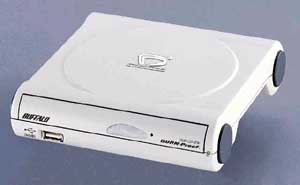
Plextor has announced a new ultrathin CD-RW PX-S88T drive. The Plextor PX-S88T has 8x record, 8x rewrite, 24x read speed and is compatible with Burn-Proof technology for the first time used on a ultrathin model. The drive has 2 MBytes buffer. Its height is only 7 mm! It will be delivered only to OEM partners of the company. It means that the model will be mainly used in notebooks.
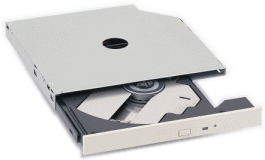
But a real record was achieved by a Sanyo drive with its 24/10/40 speed formula. Note that 24X and 10X is a constant linear velocity (CLV)! In all other respects it is a quite ordinary model: 130 ms search, 2 MBytes buffer, BURN-Proof, UltraSCSI and ATAPI variants.
At CeBIT Sanyo introduced the samples and complete specifications of the two models - CRD-BP1500 (ATAPI interface) and CRD-BP5 (SCSI interface). The drives have 24/10/40 speeds, 2 MBytes buffer, 130 ms access time and BurnProof support. Such a high record speed is achieved at the expense of Z-CLV recording method (Zone-CLV): the whole recording process is divided into three temporary parts. The recording starts at 16X. On achieving the first point the speed changes for 20x, and after the second point the speed is 24X. So, you can see that on each part CLV recording is implemented, what allows to keep stability and high record quality.

In the beginning of the March a group of companies (Sony, Thomson multimedia, Hewlett Packard, Mitsubishi chemistry, Yamaha, Ricoh and Philips) has demonstrated a new format called DVD+RW. DVD+RW is compatible with DVD players which are already under production what will help it quickly find a market. The DVD+RW standard has the following advantages:
The demonstration was carried out on a DVD+RW device from Philips and a standard DVD player from Matsushita, what revealed no compatibility problems with normal DVD devices. After that on a DVD+RW drive from Ricoh installed in a computer they recorded a disc in a DVD-VIDEO format, what was flawlessly played on a normal DVD player.
Next day Sony announced a new CD-RW drive intended for DDCDs (Double Density CD), for 1.3 GBytes discs. Note that such capacity is achieved at the expense of decreasing a distance between the neighbor tracks and and a pit length. An improved error correction technique allows to decrease sensitivity to dust and scratches. The Sony CRX200E-RP DDCD is equipped with 8 MBytes record buffer and has 12/8/32 speed formula at an average access time equal to 125 ms. The drive can record both usual CD-R/RW discs and new DDCD 1.3 GBytes ones. Possibility to record 1.3 GBytes DD-RW discs is achieved at the expense of decreasing a distance between the neighbor tracks and and a pit length, and an improved error correction technique (a laser wavelength is 780 nm). Of course DVD discs have much greater capacity, but on the other hand, Sony and Philips state that manufacturers can recast their equipment for devices with DDCD technology quite fast. Provided that the price will not differ much from normal CD-R/W and in case of a competent promotion, the new technology can take its place between CD-R and DVD. The price is still unknown. Apparently the devices will appear on the shelves in May-April 2001.

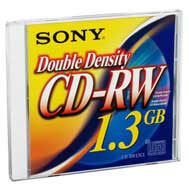
According to the company, users will have no problems with getting discs for a new device. They demonstrated a CD-RW 1.3 GBytes disc produced by Sony. TDK is also going to introduce a CD-R/W drive with 20x record speed (CLV). A disc at less than four minutes! The drive supports 10x rewrite and 40x read speed.
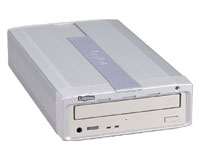
A Japanese company Logitech Inc. has announced a CD-R/W LCW-T1210BU drive with USB interface at $294. The model has 8/8/8 speed formula, BURN-Proof support and is based on the TEAC mechanics. The drives' dimensions are 160 x 280 x 59 mm at 2.5 kg weight.
Apart from DVD+RW, DDCD Sony has released a digital camera with possibility to record shots on CD-R discs. At CeBIT 2001 Sony is going to show off two new MVC-CD300 and MVC-CD200 cameras with shot recording on 8 cm CD-R discs with 156 MBytes capacity. An advantage consists in the fact that now any computer can be used for viewing them, without special adapters and software. Graphics files are kept in the universal Disc format (UDF). The next step to be made by the company is image recording on ISO-9660 discs. The MVC-CD300 ($1380) and MVC-CD200 ($1095) will appear on the market in June 2001.
While the majority of recorder manufacturers have focused on increase of record speed of CD-R discs, Elantec Semiconductor pays not less attention to a record speed of CD-RW discs. The engineers have developed a new laser EL6287C drive which will replace a currently produced EL6257C drive (it is has a full functional compatibility with the latter). At the expense of a new CMOS-technology and an improved error correction mechanism they have achieved a better ray focusing and price reduction. The EL6287C will cost $2.50 in lots from 10,000 pcs, they will hit the streets within 8 - 10 weeks.
Micro-solutions Inc. has released a new CD-RW drive with USB, PC Card and LPT interfaces. There are two variants of the model: Backpack Triple-Play with 8/4/32 speeds and Backpack Triple-Play with 8/8/32 speeds. The both models are restricted to 4x record speed in case of USB or LPT interfaces. The PC Card interface has no problems with 8x record speed. The both models are available at $269 for a 8/8/32 model and $249 for a 8/4/32 one.
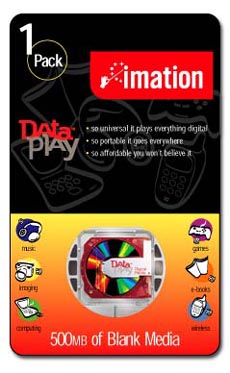
DataPlay has concluded an agreement with a sound-recording company BMG on a support of their new audio format. Similar agreements were earlier concluded by DataPlay with Universal Music Group and EMI Group. A new format of a DataPlay sound disc is a 250 MB (one-side) or 500 MBytes (two-side) miniature optical disc which can contain data recorded by a user and specially protected data from the company. A disc will be enough for 11 hours of music (or 5 full albums) with a CD-quality, several hundreds of photos or several games. The new product is scheduled for the Q4 2001, and the first discs will contain musical compositions of well known performers recorded by BMG. The new format allows to combine music, video clips, interviews, photos etc. Toshiba Corporation and Samsung Electronics are going to start production of portable players, digital cameras, PDA and peripherals for PC with DataPlay format support.
Now up DVD/CD-RW combines. In the middle of the month Matsushita announced to start shipping a portable DVD-ROM/CD-RW drive KXL-CB10AN from March 23. It features PC card TypeII interface, 8/4/24 (CD) + 8 (DVD-ROM & DVD-RAM) speeds. The drive is equipped with 2 MBytes buffer, an access time is 150ms. Unfortunately, the drive has neither BURN-Proof or JustLink support. It also lacks for an optical output. The drive is 130 x 157 x 18.5 mm, 340 g. The price is $418.
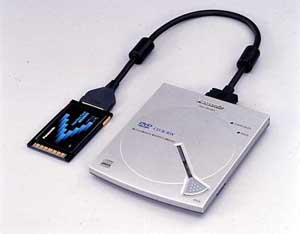
QPS Inc. is starting to ship a new external CD-RW drive with FireWire interface - Que! Fire 16x10x40 for PC and MAC computers, equipped with FireWire controllers.

As compared with the earlier 12/10/32 model, it is only a speed formula that has changed. Now it is 16/10/40. And the model costs $399.
HP has released a CD-Writer/DVD 9900ci. It is the first DVD Combo drive in the company's history. The drive can read CD-R/ROM/RW discs at 32X, rewrite CD-RW at 8X, record data on CD-R at 12x and read data from DVD discs at 8X. The drive will suit a user, in opinion of HP, both in the interface (IDE) and in the price ($350).
Together with the HP 9900ci HP has announced a HP 9710i, the first HP recorder with 16x record speed for CD-R discs. The drive is ordinary: 16/10/40 and IDE interface. We still do not know whether Burn-Proof or JustLink technologies are supported. The price is quite moderate - $299.
In the second half of the month TEAC announced a beginning of mass delivery of CD-RW5120S drive with SCSI interface. The drive has 12/10/32 speeds, the maximum data exchange rate is 20 Mbps thanks to Ultra SCSI, the buffer is 4 MBytes and the weight of the model is 2.8 kg.
A Japanese company Iodata has introduced a CDRWD-i1210J/USB drive which appears on the shelves in the end of the March at $317. The drive has 8XDVD/12/10/32 speeds and is based on the Ricoh RW9120A mechanics which supports Just Link technology.
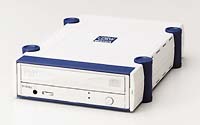
When working with USB interface, the CDRWD-i1210J/USB can operate with CD-R/W discs at 8/4/6, and with DVD-ROM discs only at 60% of the rated speed what may cause failures when playing movies from DVD Video discs. But since the drive is equipped with an alternative interface - ATAPI, it can be connected to IEEE 1394 or USB 2.0 interface via a special Iodata adapter. The products weighs 1.8 kg and measures 162 x 240 x 48 mm.
Philips announced that discs recorded in home conditions will soon have higher quality than those recorded at the factories. The company intends to introduce at CeBIT 2001 a new technology - Thermo Balanced Writing (TBW), which should optimize a recording process and guarantee a quality of data recorded on a CD. According to Benno Tieke, a developer from Philips Research Laboratories, the discs will less depend on ambient conditions - moisture and temperature, as well as on damages. Now, home-recorded discs can be read on drives of lower quality.
The crises which has taken place in many fields of electronic industry touched optical system manufacturers as well. Ricoh was first to announce a reconstruction of CD-R production. At the factory in Irwin (California), which was producing 4 million CD-R discs annually, the production has been stopped. At this time they assemble lines for manufacture of scanners and other facilities for automation of work in office. However, a number of discs produced under the Ricoh trademark, will soon even increase - the company plans to increase an order for CD-R production for Ritek from current 5 to 10 million pcs a month. As for a Ricoh's work in Japan (Atsugi), where discs for high-speed drives are produced, no changes are expected.
And now comes CeBITů The latest display wasn't very productive as far as new CD-RW drives are concerned. There are not much information on the most new products, and therefore, speed characteristics are a key parameter to judge.
Not long before the CeBIT Yamaha had surprised us with a new CD-RW drive CRW2200 with 20/10/40 speeds, 8 MBytes buffer and SafeBurn - a proprietary technology of Yamaha, equivalent to BurnProof. At CeBIT we have found out some new interesting details: the CRW2200 is a name for a whole family of drives produced in 4 variants: with SCSI, IDE, FireWire and USB 2.0 interface.
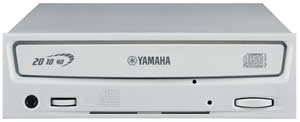
ASUSTeK has decided to release their second recorder - CRW-1610A with 16/10/40 speeds.
LiteOn and Traxdata have demonstrated identical CD-RW drives with 16/10/40 speeds. The both models have 2 MBytes buffer memory and Burn-Proof support.
Ricoh has surprised us with their new model - E-IDE MP7200A-DP drive with 20/10/40 speeds, 2 MBytes buffer and Justlink support.
TDK has shown a high-efficient Cyclone 24/10/40 based on the Sanyo transport with 2 MBytes buffer and support for a new version of CD-R protection technology - BurnProof II.
Apart from the abovementioned CRX-200 E-RP recorder, Sony has introduced a new model of a portable drive - Sony CRX-10U with 4/4/6 speeds, 8 MBytes record buffer, USB 1.1 interface and a remote controller. The product weighs only 340 (435 with a Li battery) and is capable to play MP3 discs with displaying data from ID3 Tag.

Verbatim, who has also started to deal with recorders, has introduced their internal IDE-model - CD-RW1610 with ordinary 16/10/40 speeds. As for an internal layout, the drive is standard: 2 MBytes buffer, Write-Proof (an analog of the Burn-Proof) support, what makes me think that the model is based on TEAC components. The CD-RW drive will be shipping with software from ahead Software (Nero Burning ROM, Nero InCD and Nero MediaPlayer). The device will appear on the shelves not earlier than April.
Now a little bit on combines.
ASUS has shown off its DRW-2010R with 10DVD/20/10/40 speeds! The price is still in secret, but the device is scheduled for the market in May-June.
A model from Philips has an analog speed formula - 10DVD/20/10/40, and is expected to appear within the nearest months at $400.
The Ricoh MP9120A-DP: a new combo from Ricoh with IDE interface has 8DVD/12/10/32 speeds. The buffer is 2 MBytes, the buffer underrun error prevention technology is Justlink, an access time is 100 ms.
Memorex Twelvemax: the model due to replace the previous Trimaxx model has 8DVD/12/10/32 speeds.
Such a variety of new technologies should bring about recording of 650 MB CD-R disc at one-two minutes. How high quality will be in this case I say only when CD-RW drives and discs will really support more than 16X record speed.
|
Tweet | ||
This month's CeBIT is nearly the most important event of this half a year, since the products shown off there will appear in the market in the nearest time. And now I want to trace main ways of development of DVD technologies according to the display's results.
It seems that DVD-ROM drives have reached its maximum/optimal speed - 16x. Further, the policy will be aimed at cutting their price in order to replace CD-ROMs. Almost all manufacturers have reached 16X. I wish they went further, since there are still no real applications which will require such a high speed, whereas an increased noise level is a reality.
For speed strivers Infineon has offered a variant of a chipset called "Raptor" for a DVD/CD-ROM drive based on TrueX Multibeam technology from Zen Research.
With this technology in use one can create a DVD-ROM drive with speed up to 25X, and a CD-ROM one with up to 100X speed. But such devices are not popular since they cost twice more as compared with usual ones. But nevertheless, Infineon together with Sanyo and Zen Research have shown off a sample of a 25X DVD-ROM drive.
Another interesting technology is Super Clamp from Digital Video Systems. which ensures reading of heavy scratched discs.
Such devices are becoming more and more popular. In standard PCs it is accounted for by a frequent usage of NLX and MicroATX cases. With only one 5" slot such cases are low flexible, as far as drives are concerned. This solution gives small dimensions and maximum functionality what is very convenient for notebooks. The latest versions of COMBO devices use an up-to-date CD-RW scheme with up to 20X10x speeds with support of a technology of Burn-proof type and a DVD scheme with 10x speed. Here are some examples.
ASUS DRW-2010R - a scheme of the model is 10-DVD/20-R/10-RW/40-CD. The drive is only a pre-production sample and mass deliveries will start in the end of the summer.
Philips introduced a model with 10-DVD/20-R/10-RW/40-CD speeds. No more information on this drive apart from the fact that it will appear on the shelves in autumn.
RICOH MP9120A-DP showed off a model with 8-DVD/12-R/10-RW/32-CD speeds. It was first to launch a drive with such speed formula and has been selling it several months already both to end users and as an OEM product to other companies. The two last models in this list are OEM variants from Ricoh.
Memorex Twelvemax - a scheme of the model is 8-DVD/12-R/10-RW/32-CD.
HP 9900CI - a scheme of the model is 8-DVD/12-R/10-RW/32-CD.
While big companies are preparing for a large-scale production of recording DVD devices, small firms are hurrying to release their products to take their share in this market. Now comes the price list. Price wars have caused the prices of $1500 for a device to fall down to $800. If the trend keeps by the end of the summer you can get a device at $500. Reportedly, recording DVD manufacturers will produce their products for PCs on a par with home DVD recorders. Let's look at some definite models of DVD recorders.
Pioneer has shown off their DVR-A03 drive (we have already written about it in the January digest). The new information concerns its price which is $900, plus its further firmware versions will allow to work with DVD-RW discs. Note that initially it was selling as a DVD-R drive.
Panasonic introduced a Combo DVD drive capable to write not only DVD-RAM discs but also DVD-R ones.
Record of DVD-RAM (4.7 GBytes and 2.6 Gb), DVD-R (4.7Gb)
Reading of DVD-ROM, DVD-RAM, DVD-R,DVD video, CD-ROM, CD-R/RW.
Unfortunately, the price is unknown, but nevertheless, it is very interesting project.
Apart from the Philips drive we managed to get one more DVD+RW drive. The Ricoh device could write not only DVD+RW but also CD-RW discs. In the prototype two separate optical system for recording CD and DVD were used. The max record speed for DVD+RW is 2.5X, for CD-RW - 12X/10X. We should expect that at the nearest displays other participants of a DVD+ alliance will introduce their prototypes also. Such devices are expected to enter the mass market in autumn this year. The price will be around from $800 to 999.
The materials from the following sites were used for the review:
and from the following manufacturers' sites:
Write a comment below. No registration needed!
|
Article navigation: |
| blog comments powered by Disqus |
| Most Popular Reviews | More RSS |
 |
Comparing old, cheap solutions from AMD with new, budget offerings from Intel.
February 1, 2013 · Processor Roundups |
 |
Inno3D GeForce GTX 670 iChill, Inno3D GeForce GTX 660 Ti Graphics Cards A couple of mid-range adapters with original cooling systems.
January 30, 2013 · Video cards: NVIDIA GPUs |
 |
Creative Sound Blaster X-Fi Surround 5.1 An external X-Fi solution in tests.
September 9, 2008 · Sound Cards |
 |
The first worthwhile Piledriver CPU.
September 11, 2012 · Processors: AMD |
 |
Consumed Power, Energy Consumption: Ivy Bridge vs. Sandy Bridge Trying out the new method.
September 18, 2012 · Processors: Intel |
| Latest Reviews | More RSS |
 |
Retested all graphics cards with the new drivers.
Oct 18, 2013 · 3Digests
|
 |
Added new benchmarks: BioShock Infinite and Metro: Last Light.
Sep 06, 2013 · 3Digests
|
 |
Added the test results of NVIDIA GeForce GTX 760 and AMD Radeon HD 7730.
Aug 05, 2013 · 3Digests
|
 |
Gainward GeForce GTX 650 Ti BOOST 2GB Golden Sample Graphics Card An excellent hybrid of GeForce GTX 650 Ti and GeForce GTX 660.
Jun 24, 2013 · Video cards: NVIDIA GPUs
|
 |
Added the test results of NVIDIA GeForce GTX 770/780.
Jun 03, 2013 · 3Digests
|
| Latest News | More RSS |
Platform · Video · Multimedia · Mobile · Other || About us & Privacy policy · Twitter · Facebook
Copyright © Byrds Research & Publishing, Ltd., 1997–2011. All rights reserved.